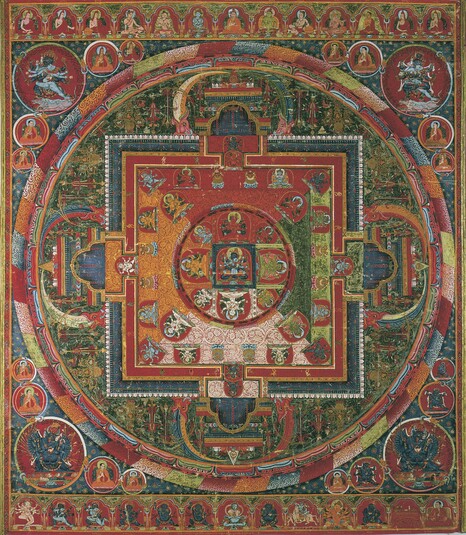
Item: Mandala of Guhyasamaja (Buddhist Deity) - Akshobhyavajra
| Origin Location | Tibet |
|---|---|
| Date Range | 1300 - 1399 |
| Lineages | Sakya and Buddhist |
| Material | Ground Mineral Pigment on Cotton |
| Collection | Margot and Tom Pritzker |
Akshobhyavajra Guhyasamaja Mandala. A set of forty-two mandalas, as described in the Vajravali Sanskrit text of Abhayakaragupta, commissioned in honour of Lama Dampa Sonam Gyaltsen (1312-1375).
Based on one interpretation of the reading of the Tibetan inscription at the bottom right, the donor of the painting set was Chen-nga Chenpo (1310-1370) the son of Pagdru Jangchub Gyaltsen. Chen-nga Chenpo was offered the title of Chen-nga when he returned to Densatil in the 1360s, however he passed away before Lama Dampa. Is it possible that this set of paintings were created to honour Lama Dampa by his devoted student while both were still alive? This would place the date of creation roughly between 1365 and 1370?
The name inscription at the top center is Lama Dampa Sonam Gyaltsen. The donor inscription at the bottom right corner, according to one possible reading, is Chen-nga Chenpo. This is the only painting in the set of compositions that appears to have the full name of the top figure and also the name of the donor figure.
Akshobhyavajra Guhyasamaja Description: "...with a body blue in colour like sapphire, issuing forth rays of blazing light. The main face is blue with a mixed expression of fierceness and desire. The canine teeth are pointed and clenched, frowning and having three eyes. The right face is white in a peaceful manner, left face is red in a desirous manner. All three faces are adorned with very beautiful eyebrows. Each of the six hands are adorned with precious rings. The first two hands hold a nine pointed vajra and a bell embracing the consort [who is in] the same [appearance] as the [Father]. The right second [hand] holds a white wheel with eight spokes. The third [hand] holds a red lotus with eight petals. The left second [hand] holds a green jewel with nine facets. The third [hand] holds a sword, bright blue and blazing with rays of light. Seated with the legs in vajra posture, adorned with the thirty-two major and eighty minor marks, the hair, in braids, is tied on the crown of the head. The jewel on the crown of the head greatly blazes with soothing rays of light [like] the sun and moon. Adorned with eight [different types] of precious ornaments: a crown, earrings, choker, necklace, armlets, bracelets, long necklace and belt. The ears are made more beautiful with blue utpalas and ribbons; wearing various [heavenly] garments bright like Indra's bow [rainbow]." (Jamgon Amezhab, 1597-1659).
Jeff Watt 8-2009

Front of Painting
English Translation of Inscription: Lama Dampa Sonam Gyaltsen la namo. spyan snga chen po.
Exhibition: Mandala, The Perfect Circle (RMA)
Thematic Sets
Painting Set: Vajravali (Lama Dampa Set)
Buddhist Deity: Guhyasamaja (Masterworks)
Collection of Margot and Tom Pritzker (Paintings)
Guhyasamaja, Akshobhyavajra (Mandala Masterworks)
Buddhist Deity: Guhyasamaja (Early Works)
Buddhist Deity: Guhyasamaja, Akshobhyavajra
